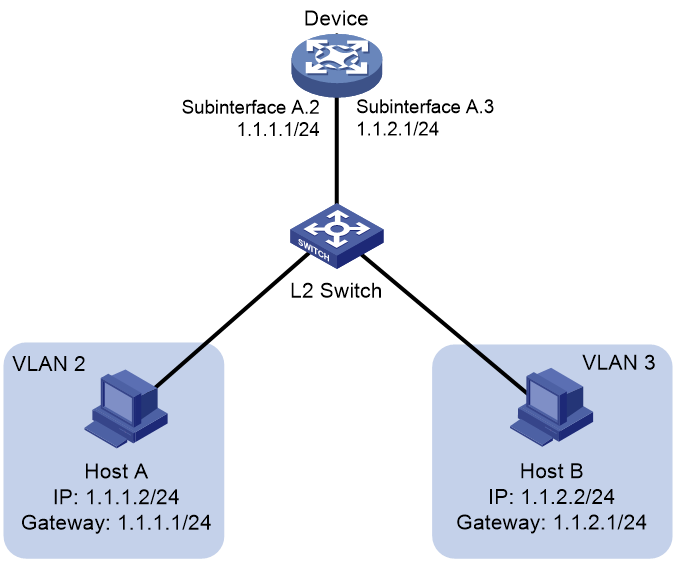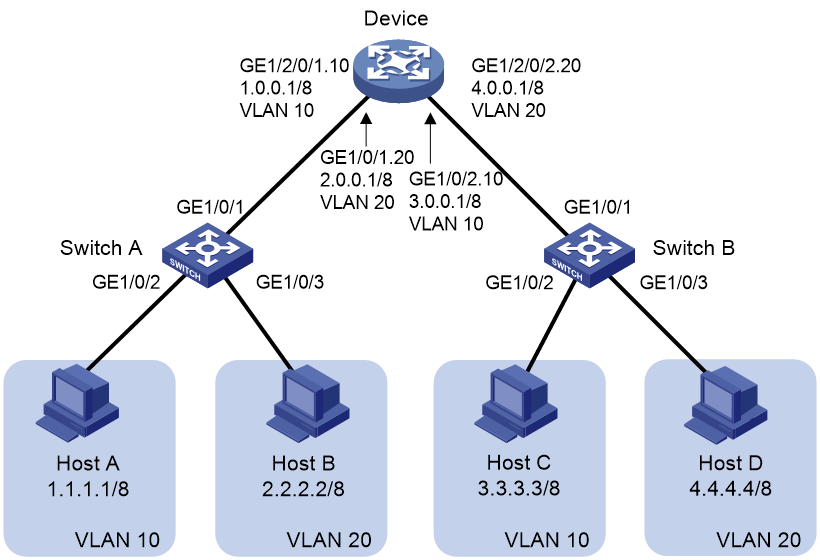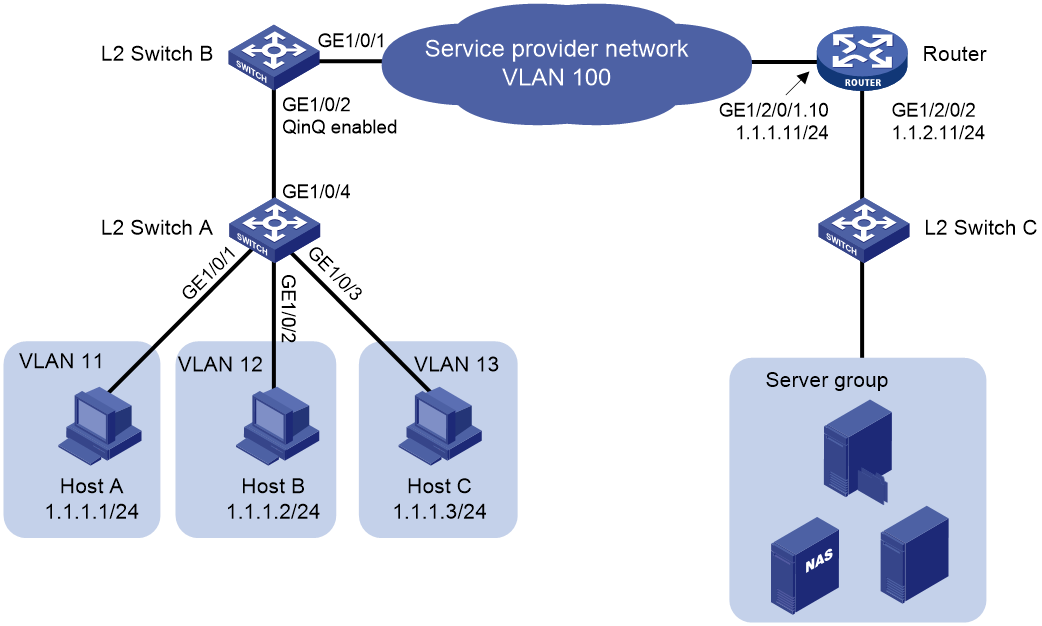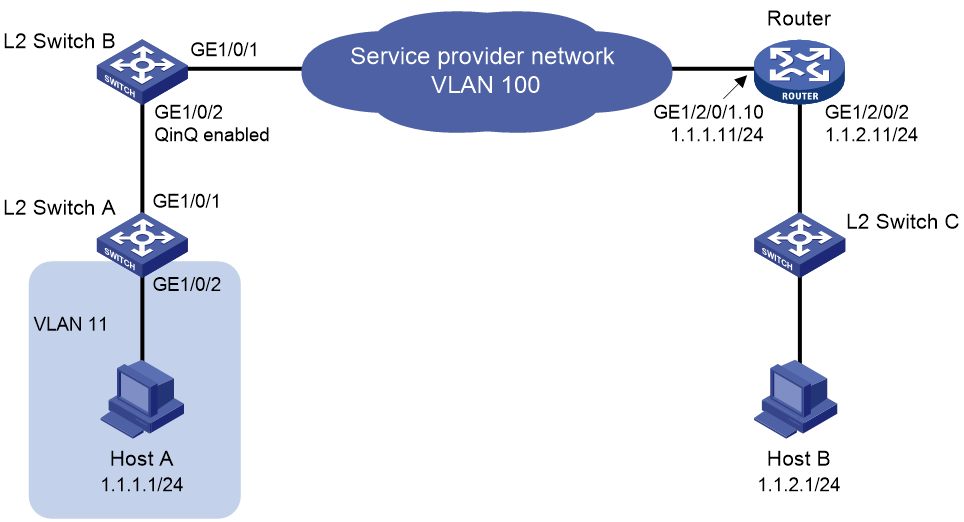- Table of Contents
- Related Documents
-
| Title | Size | Download |
|---|---|---|
| 05-VLAN termination configuration | 220.34 KB |
VLAN termination application scenarios
Restrictions and guidelines: VLAN termination configuration
VLAN termination tasks at a glance
Configuring ambiguous Dot1q termination
Configuring common ambiguous Dot1q termination
Configuring unambiguous Dot1q termination
Configuring common unambiguous Dot1q termination
Configuring ambiguous QinQ termination
About ambiguous QinQ termination
Configuring ambiguous QinQ termination by specifying the outermost two layers of VLAN ID ranges
Configuring unambiguous QinQ termination
About unambiguous QinQ termination
Configuring unambiguous QinQ termination by specifying the outermost two layers of VLAN IDs
Enabling a VLAN termination-enabled interface to transmit broadcasts and multicasts
Enabling user mode of VLAN termination
Display and maintenance commands for VLAN termination
VLAN termination configuration examples
Example: Configuring ambiguous Dot1q termination
Example: Configuring unambiguous Dot1q termination
Configuring VLAN termination
About VLAN termination
VLAN termination typically processes packets that include VLAN tags. A VLAN termination-enabled interface performs the following tasks when receiving a VLAN-tagged packet:
1. Assigns the packet to an interface according to its VLAN tags.
2. Removes the VLAN tags of the packet.
3. Delivers the packet to Layer 3 forwarding or other processing pipelines.
Before sending the packet, the VLAN termination-enabled interface determines whether to add new VLAN tags to the packet, based on the VLAN termination type.
VLAN termination can also process packets that do not include any VLAN tags.
This document uses the following VLAN tag concepts for a packet that has two or more layers of VLAN tags:
· Layer 1 VLAN tag—Specifies the outermost layer of VLAN tags.
· Layer 2 VLAN tag—Specifies the second outermost layer of VLAN tags.
The VLAN IDs of the packets are numbered in the same manner as the VLAN tags.
VLAN termination types
|
Types of packets to be terminated on the interface |
Tags of outgoing packets on the interface |
|
|
Dot1q termination |
The packets must meet both of the following requirements: · The packets include one or more layers of VLAN tags. · The outermost VLAN ID matches the configured value. |
Single-tagged |
|
QinQ termination |
The packets must meet both of the following requirements: · The packets include two or more layers of VLAN tags. · The outermost two layers of tags match the configured values. |
Double-tagged |
|
Untagged termination |
Untagged packets. |
Untagged |
|
Default termination |
Packets that cannot be processed on any other subinterfaces of the same main interface. |
Untagged |
VLAN termination mechanism
Subinterfaces (including Layer 3 Ethernet subinterfaces and Layer 3 aggregate subinterfaces) can terminate packets whose outermost one or two layers of VLAN IDs match specific values.
A main interface does not terminate VLAN-tagged packets (for example, Layer 3 Ethernet interface or Layer 3 aggregate interface). To terminate VLAN-tagged packets, create subinterfaces for the main interface.
Subinterfaces of the same main interface can use different types of VLAN termination. To process received packets, the system selects a subinterface based on the following VLAN termination types in descending order of priority:
· QinQ termination.
· Dot1q termination or support for Dot1q termination by default.
If none of these VLAN termination types applies, the main interface processes the packets.
VLAN termination application scenarios
Inter-VLAN communication
Hosts in different VLANs cannot directly communicate with each other. You can use Layer 3 routing to allow all VLANs to communicate.
As shown in Figure 1, Host A and Host B are in different VLANs. For the two hosts to communicate with each other, perform the following tasks:
1. Specify 1.1.1.1/24 and 1.1.2.1/24 as the gateway IP address for Host A and Host B, respectively.
2. On the device, configure Dot1q termination on Layer 3 Ethernet subinterfaces Subinterface A.2 and Subinterface A.3.
Figure 1 Inter-VLAN communication through Layer 3 subinterfaces
LAN-WAN communication
Typically, WAN protocols such as PPP do not recognize VLAN-tagged packets from LANs. Before packets are sent to a WAN, the sending port must locally record the VLAN information and remove VLAN tags from the packets.
As shown in Figure 2, a host is located on a customer network and wants to access the WAN network through a PPPoE connection. CVLAN and SVLAN represent the VLAN on the customer network and service provider network, respectively.
To access the WAN network, a packet originating from the host is processed as follows:
1. Layer 2 Switch A adds a CVLAN tag to the packet and sends the packet.
2. Layer 2 Switch B adds an SVLAN tag to the packet on the QinQ-enabled port.
3. The packet is forwarded on the service provider network based on the SVLAN tag.
4. The gateway removes the two layers of VLAN tags from the packet and adds new VLAN tags on the QinQ termination-enabled port.
5. The gateway sends the packet to the WAN.
Figure 2 VLAN termination enables LAN-WAN communication
Restrictions and guidelines: VLAN termination configuration
When you configure VLAN termination, follow these restrictions and guidelines:
· By default, after you modify the VLAN termination configuration for a subinterface, the subinterface flaps once. All dynamic ARP table entries for the subinterface are deleted. At the same time, another subinterface on the same main interface also flaps if it meets the following conditions:
¡ It terminates the same Layer 1 VLAN ID as the modified subinterface.
¡ It terminates any Layer 2 VLAN IDs.
For example, the vlan-type dot1q vid 200 second-dot1q 10 setting exists on subinterface A.2, and the vlan-type dot1q vid 200 second-dot1q any setting exists on subinterface A.3. If you modify the VLAN termination configuration on subinterface A.2, both subinterface A.2 and subinterface A.3 flap.
To avoid this issue, configure the vlan-termination user-mode command on the subinterface. For more information, see "Enabling user mode of VLAN termination".
VLAN termination tasks at a glance
To configure VLAN termination, perform the following tasks:
1. (Required.) Configuring VLAN termination
Choose one of the following tasks:
¡ Configuring ambiguous Dot1q termination
¡ Configuring unambiguous Dot1q termination
¡ Configuring ambiguous QinQ termination
¡ Configuring unambiguous QinQ termination
2. (Optional.) Enabling a VLAN termination-enabled interface to transmit broadcasts and multicasts
Perform this task to enable VLAN termination-enabled interfaces to transmit broadcasts and multicasts.
3. (Optional.) Enabling user mode of VLAN termination
Perform this task to prevent subinterface restart caused by VLAN termination setting modification.
Configuring ambiguous Dot1q termination
About this task
Use this feature to terminate VLAN-tagged packets whose outermost VLAN IDs are in the specified range. Other VLAN-tagged packets are not allowed to pass.
When an interface receives a packet, it removes the outermost VLAN ID from the packet. When the interface sends a packet, it tags the packet with a VLAN ID as follows:
· For a DHCP relay packet, the VLAN ID is from the matching DHCP session entry.
· For an IPv4 or MPLS packet, the VLAN ID is from the matching ARP entry.
Configuring common ambiguous Dot1q termination
1. Enter system view.
system-view
2. Enter interface view.
¡ Enter Layer 3 Ethernet subinterface view.
interface interface-type interface-number.subnumber
¡ Enter Layer 3 aggregate subinterface view.
interface route-aggregation interface-number.subnumber
3. Configure ambiguous Dot1q termination.
vlan-type dot1q vid vlan-id-list
By default, Dot1q termination is disabled on a subinterface.
Configuring unambiguous Dot1q termination
About this task
Use this feature to terminate only VLAN-tagged packets whose outermost VLAN ID matches the specified VLAN ID. Other VLAN-tagged packets are not allowed to pass.
When an interface receives a packet, it removes the outermost VLAN ID from the packet. When the interface sends a packet, it tags the packet with the specified VLAN ID.
Configuring common unambiguous Dot1q termination
1. Enter system view.
system-view
2. Enter interface view.
¡ Enter Layer 3 Ethernet subinterface view.
interface interface-type interface-number.subnumber
¡ Enter Layer 3 aggregate subinterface view.
interface route-aggregation interface-number.subnumber
3. Configure unambiguous Dot1q termination.
vlan-type dot1q vid vlan-id
By default, Dot1q termination is disabled on a subinterface.
Configuring ambiguous QinQ termination
About ambiguous QinQ termination
Use this feature to terminate QinQ packets whose outermost two layers of VLAN IDs are in the specified range.
When an interface receives a packet, it removes the outermost two layers of VLAN tags from the packet. When the interface sends a packet, it tags the packet with the outermost two layers of VLAN IDs, which are determined as follows:
· For a DHCP relay packet, VLAN IDs are from the matching DHCP relay entry.
· For an IPv4 or MPLS packet, VLAN IDs are from the matching ARP entry.
Configuring ambiguous QinQ termination by specifying the outermost two layers of VLAN ID ranges
Restrictions and guidelines
· If you specify the same Layer 1 VLAN ID for multiple subinterfaces of the same main interface, specify different Layer 2 VLAN IDs for them. However, if you specify different Layer 1 VLAN IDs for the subinterfaces, the Layer 2 VLAN IDs specified for the subinterfaces are not required to be different.
· Subinterfaces of different main interfaces can terminate VLAN-tagged packets with the same Layer 1 and Layer 2 VLAN IDs.
· If you execute the vlan-type dot1q vid second-dot1q command multiple times, all specified pairs of Layer 1 IDs and Layer 2 IDs in each execution take effect.
Configuring common ambiguous QinQ termination
1. Enter system view.
system-view
2. Enter interface view.
¡ Enter Layer 3 Ethernet subinterface view.
interface interface-type interface-number.subnumber
¡ Enter Layer 3 aggregate subinterface view.
interface route-aggregation interface-number.subnumber
3. Configure ambiguous QinQ termination by specifying the outermost two layers of VLAN ID ranges.
vlan-type dot1q vid vlan-id-list second-dot1q { vlan-id-list | any }
By default, QinQ termination is disabled on a subinterface.
Configuring ambiguous user VLAN QinQ termination
1. Enter system view.
system-view
2. Enter interface view.
¡ Enter Layer 3 Ethernet subinterface view.
interface interface-type interface-number.subnumber
¡ Enter Layer 3 aggregate subinterface view.
interface route-aggregation interface-number.subnumber
3. Configure ambiguous user VLAN QinQ termination by specifying the outermost two layers of VLAN ID ranges.
user-vlan dot1q vid vlan-id-list second-dot1q { vlan-id-list | any } [ loose ]
By default, user VLAN QinQ termination is disabled on a subinterface.
Configuring unambiguous QinQ termination
About unambiguous QinQ termination
Use this feature to terminate QinQ packets whose outermost two layers of VLAN IDs match the specified values.
When an interface receives a packet, it removes the two layers of VLAN tags from the packet. When the interface sends the packet, it tags the packet with two layers of VLAN tags as specified.
Configuring unambiguous QinQ termination by specifying the outermost two layers of VLAN IDs
Configuring common unambiguous QinQ termination by specifying the outermost two layers of VLAN IDs
1. Enter system view.
system-view
2. Enter interface view.
¡ Enter Layer 3 Ethernet subinterface view.
interface interface-type interface-number.subnumber
¡ Enter Layer 3 aggregate subinterface view.
interface route-aggregation interface-number.subnumber
3. Configure unambiguous QinQ termination by specifying the outermost two layers of VLAN IDs.
vlan-type dot1q vid vlan-id second-dot1q vlan-id
By default, QinQ termination is disabled on a subinterface.
Enabling a VLAN termination-enabled interface to transmit broadcasts and multicasts
About this task
After you configure Dot1q/ QinQ termination on an interface to terminate packets of multiple VLANs, the interface drops broadcast and multicast packets by default. Use this feature to enable the interface to transmit broadcasts and multicasts.
To transmit a broadcast or multicast packet, the interface starts a traversal over all the VLAN IDs specified for Dot1q/QinQ termination. It copies the packet and tags each copy with VLAN IDs, until all combinations of VLAN IDs are traversed. For example, when ambiguous QinQ termination is configured, both layers of VLAN ID ranges are traversed.
Restrictions and guidelines
You must use the vlan-termination broadcast ra command to enable an ambiguous Dot1q or QinQ termination-enabled interface to transmit RA multicast packets on an IPv6 network. This command prohibits transmission of broadcast packets and other types of multicast packets, and consumes less CPU resources than the vlan-termination broadcast enable command.
When you execute the vlan-termination broadcast ra command on an interface, configure the undo ipv6 nd ra halt command to allow the interface to advertise RA messages. For more information about the undo ipv6 nd ra halt command, see Layer 3—IP Services Command Reference.
Procedure
1. Enter system view.
system-view
2. Enter interface view.
¡ Enter Layer 3 Ethernet subinterface view.
interface interface-type interface-number.subnumber
¡ Enter Layer 3 aggregate subinterface view.
interface route-aggregation interface-number.subnumber
¡ Enter VLAN interface view.
interface vlan-interface interface-number
3. Enable the interface to transmit broadcasts and multicasts.
¡ Enable the interface to transmit broadcasts and multicasts.
vlan-termination broadcast enable
¡ Enable the interface to transmit only RA multicasts on an IPv6 network.
vlan-termination broadcast ra
By default, broadcast and multicast packets are dropped on an interface configured with Dot1q/QinQ termination to terminate packets of multiple VLANs.
Enabling user mode of VLAN termination
About this task
If user mode of VLAN termination is disabled on a subinterface, the subinterface automatically restarts after you modify its VLAN termination settings. In some networks, the subinterface restart logs off online users. To prevent the subinterface restart and protect the online user state, enable user mode of VLAN termination before you modify VLAN termination on the subinterface.
Restrictions and guidelines
After you enable user mode of VLAN termination and modify VLAN termination on a subinterface, clear entries of VLANs that are no longer terminated by the subinterface. If you do not clear these entries, running services might be affected. For example, after you modify VLAN termination on a subinterface, perform the following tasks for the subinterface:
· Use the reset arp interface command in user view to clear all ARP entries.
· Use the reset ipv6 neighbors interface command in user view to clear all dynamic neighbors.
For more information about the reset arp and reset ipv6 neighbors commands, see ARP and IPv6 basics commands in Layer 3—IP Services Command Reference.
Procedure
1. Enter system view.
system-view
2. Enter interface view.
¡ Enter Layer 3 Ethernet subinterface view.
interface interface-type interface-number.subnumber
¡ Enter Layer 3 aggregate subinterface view.
interface route-aggregation interface-number.subnumber
3. Enable user mode of VLAN termination.
vlan-termination user-mode
By default, user mode of VLAN termination is disabled.
Display and maintenance commands for VLAN termination
Execute display commands in any view.
|
Task |
Command |
|
Display user VLAN termination information. |
display user-vlan interface interface-type interface-number.subnumber [ chassis chassis-number slot slot-number ] |
VLAN termination configuration examples
Example: Configuring ambiguous Dot1q termination
Network configuration
As shown in Figure 3, configure ambiguous Dot1q termination so that hosts in different VLANs can communicate with the server group.
Procedure
In this example, L2 Switch B uses the factory configuration.
1. Configure Host A, Host B, and Host C:
# Assign 1.1.1.1/24, 1.1.1.2/24, and 1.1.1.3/24 to Host A, Host B, and Host C, respectively. (Details not shown.)
# Specify 1.1.1.11/24 as the gateway IP address for the hosts. (Details not shown.)
2. Configure Layer 2 Switch A:
# Create VLAN 11.
<L2_SwitchA> system-view
[L2_SwitchA] vlan 11
# Assign GigabitEthernet 1/0/1 to VLAN 11.
[L2_SwitchA-vlan11] port gigabitethernet 1/0/1
[L2_SwitchA-vlan11] quit
# Create VLAN 12.
[L2_SwitchA] vlan 12
# Assign GigabitEthernet 1/0/2 to VLAN 12.
[L2_SwitchA-vlan12] port gigabitethernet 1/0/2
[L2_SwitchA-vlan12] quit
# Create VLAN 13.
[L2_SwitchA] vlan 13
# Assign GigabitEthernet 1/0/3 to VLAN 13.
[L2_SwitchA-vlan13] port gigabitethernet 1/0/3
[L2_SwitchA-vlan13] quit
# Configure GigabitEthernet 1/0/4 as a trunk port and assign the port to VLANs 11 through 13.
[L2_SwitchA] interface gigabitethernet 1/0/4
[L2_SwitchA-GigabitEthernet1/0/4] port link-type trunk
[L2_SwitchA-GigabitEthernet1/0/4] port trunk permit vlan 11 to 13
3. Configure the device:
# Create Ethernet subinterface GigabitEthernet 1/2/0/1.10 and assign an IP address to the subinterface.
<Device> system-view
[Device] interface gigabitethernet 1/2/0/1.10
[Device-GigabitEthernet1/2/0/1.10] ip address 1.1.1.11 255.255.255.0
# Enable Dot1q termination on GigabitEthernet 1/2/0/1.10 to terminate VLAN-tagged packets whose Layer 1 VLAN IDs are 11, 12, or 13.
[Device-GigabitEthernet1/2/0/1.10] vlan-type dot1q vid 11 to 13
# Enable GigabitEthernet 1/2/0/1.10 to transmit broadcasts and multicasts.
[Device-GigabitEthernet1/2/0/1.10] vlan-termination broadcast enable
[Device-GigabitEthernet1/2/0/1.10] quit
# Configure an IP address for GigabitEthernet 1/2/0/2.
[Device] interface gigabitethernet 1/2/0/2
[Device-GigabitEthernet1/2/0/2] ip address 1.1.2.11 255.255.255.0
4. Configure the server group:
# Assign each device in the server group an IP address on network segment 1.1.2.0/24. (Details not shown.)
# Specify 1.1.2.11/24 as the gateway IP address for the server group. (Details not shown.)
Verifying the configuration
# Verify that Host A, Host B, and Host C can ping the device in the server group. (Details not shown.)
Example: Configuring unambiguous Dot1q termination
Network configuration
As shown in Figure 4, configure unambiguous Dot1q termination on subinterfaces of the device to implement intra-VLAN and inter-VLAN communications between hosts.
Procedure
1. Configure Host A, Host B, Host C, and Host D:
# On Host A, specify 1.1.1.1/8 and 1.0.0.1/8 as its IP address and gateway IP address, respectively. (Details not shown.)
# On Host B, specify 2.2.2.2/8 and 2.0.0.1/8 as its IP address and gateway IP address, respectively. (Details not shown.)
# On Host C, specify 3.3.3.3/8 and 3.0.0.1/8 as its IP address and gateway IP address, respectively. (Details not shown.)
# On Host D, specify 4.4.4.4/8 and 4.0.0.1/8 as its IP address and gateway IP address, respectively. (Details not shown.)
2. Configure Layer 2 Switch A:
# Create VLAN 10.
<L2_SwitchA> system-view
[L2_SwitchA] vlan 10
# Assign GigabitEthernet 1/0/2 to VLAN 10.
[L2_SwitchA-vlan10] port gigabitethernet 1/0/2
[L2_SwitchA-vlan10] quit
# Create VLAN 20.
[L2_SwitchA] vlan 20
# Assign GigabitEthernet 1/0/3 to VLAN 20.
[L2_SwitchA-vlan20] port gigabitethernet 1/0/3
[L2_SwitchA-vlan20] quit
# Configure GigabitEthernet 1/0/1 as a trunk port, and assign the port to VLANs 10 and 20.
[L2_SwitchA] interface gigabitethernet 1/0/1
[L2_SwitchA-GigabitEthernet1/0/1] port link-type trunk
[L2_SwitchA-GigabitEthernet1/0/1] port trunk permit vlan 10 20
3. Configure Layer 2 Switch B in the same way you configure Layer 2 Switch A. (Details not shown.)
4. Configure the device:
# Create GigabitEthernet 1/2/0/1.10 and assign an IP address to this interface.
<Device> system-view
[Device] interface gigabitethernet 1/2/0/1.10
[Device-GigabitEthernet1/2/0/1.10] ip address 1.0.0.1 255.0.0.0
# Configure GigabitEthernet 1/2/0/1.10 to terminate packets tagged with VLAN 10.
[Device-GigabitEthernet1/2/0/1.10] vlan-type dot1q vid 10
[Device-GigabitEthernet1/2/0/1.10] quit
# Create GigabitEthernet 1/2/0/1.20 and assign an IP address to this interface.
[Device] interface gigabitethernet 1/2/0/1.20
[Device-GigabitEthernet1/2/0/1.20] ip address 2.0.0.1 255.0.0.0
# Configure GigabitEthernet 1/2/0/1.20 to terminate packets tagged with VLAN 20.
[Device-GigabitEthernet1/2/0/1.20] vlan-type dot1q vid 20
[Device-GigabitEthernet1/2/0/1.20] quit
# Configure GigabitEthernet 1/2/0/2.10 and assign an IP address to this interface.
[Device] interface gigabitethernet 1/2/0/2.10
[Device-GigabitEthernet1/2/0/2.10] ip address 3.0.0.1 255.0.0.0
# Configure GigabitEthernet 1/2/0/2.10 to terminate packets tagged with VLAN 10.
[Device-GigabitEthernet1/2/0/2.10] vlan-type dot1q vid 10
[Device-GigabitEthernet1/2/0/2.10] quit
# Configure GigabitEthernet 1/2/0/2.20 and assign an IP address to this interface.
[Device] interface gigabitethernet 1/2/0/2.20
[Device-GigabitEthernet1/2/0/2.20] ip address 4.0.0.1 255.0.0.0
# Configure GigabitEthernet 1/2/0/2.20 to terminate packets tagged with VLAN 20.
[Device-GigabitEthernet1/2/0/2.20] vlan-type dot1q vid 20
Verifying the configuration
# Verify that Host A, Host B, Host C, and Host D can ping each other. (Details not shown.)
Example: Configuring ambiguous QinQ termination
Network configuration
As shown in Figure 5, QinQ is enabled on GigabitEthernet 1/0/2 of Layer 2 Switch B.
Configure ambiguous QinQ termination, so that hosts can communicate with the server group.
Procedure
In this example, Layer 2 Switch C uses the factory configuration.
1. Configure Host A, Host B, and Host C:
# Assign the IP addresses 1.1.1.1/24, 1.1.1.2/24, and 1.1.1.3/24 to Host A, Host B, and Host C, respectively. (Details not shown.)
# Specify 1.1.1.11/24 as the gateway address for the hosts. (Details not shown.)
2. Configure Layer 2 Switch A:
# Create VLAN 11.
<L2_SwitchA> system-view
[L2_SwitchA] vlan 11
# Assign GigabitEthernet 1/0/1 to VLAN 11.
[L2_SwitchA-vlan11] port gigabitethernet 1/0/1
[L2_SwitchA-vlan11] quit
# Create VLAN 12.
[L2_SwitchA] vlan 12
# Assign GigabitEthernet 1/0/2 to VLAN 12.
[L2_SwitchA-vlan12] port gigabitethernet 1/0/2
[L2_SwitchA-vlan12] quit
# Create VLAN 13.
[L2_SwitchA] vlan 13
# Assign GigabitEthernet 1/0/3 to VLAN 13.
[L2_SwitchA-vlan13] port gigabitethernet 1/0/3
[L2_SwitchA-vlan13] quit
# Configure GigabitEthernet 1/0/4 as a trunk port, and assign the port to VLANs 11 through 13.
[L2_SwitchA] interface gigabitethernet 1/0/4
[L2_SwitchA-GigabitEthernet1/0/4] port link-type trunk
[L2_SwitchA-GigabitEthernet1/0/4] port trunk permit vlan 11 to 13
3. Configure Layer 2 Switch B:
# Configure GigabitEthernet 1/0/2 as a trunk port, and assign the port to VLANs 11 through 13 and VLAN 100.
<L2_SwitchB> system-view
[L2_SwitchB] interface gigabitethernet 1/0/2
[L2_SwitchB-GigabitEthernet1/0/2] port link-type trunk
[L2_SwitchB-GigabitEthernet1/0/2] port trunk permit vlan 11 to 13 100
# Set the PVID of GigabitEthernet 1/0/2 to VLAN 100.
[L2_SwitchB-GigabitEthernet1/0/2] port trunk pvid vlan 100
# Enable QinQ on GigabitEthernet 1/0/2.
[L2_SwitchB-GigabitEthernet1/0/2] qinq enable
[L2_SwitchB-GigabitEthernet1/0/2] quit
# Configure GigabitEthernet 1/0/1 as a trunk port and assign the port to VLAN 100.
[L2_SwitchB] interface gigabitethernet 1/0/1
[L2_SwitchB-GigabitEthernet1/0/1] port link-type trunk
[L2_SwitchB-GigabitEthernet1/0/1] port trunk permit vlan 100
4. Configure the router:
# Create Ethernet subinterface GigabitEthernet 1/2/0/1.10 and assign an IP address to the subinterface.
<Router> system-view
[Router] interface gigabitethernet 1/2/0/1.10
[Router-GigabitEthernet1/2/0/1.10] ip address 1.1.1.11 255.255.255.0
# Configure GigabitEthernet 1/2/0/1.10 to terminate VLAN-tagged packets whose Layer 1 VLAN ID is 100 and Layer 2 VLAN ID is 11, 12, or 13.
[Router-GigabitEthernet1/2/0/1.10] vlan-type dot1q vid 100 second-dot1q 11 to 13
# Enable GigabitEthernet 1/2/0/1.10 to transmit broadcasts and multicasts.
[Router-GigabitEthernet1/2/0/1.10] vlan-termination broadcast enable
[Router-GigabitEthernet1/2/0/1.10] quit
# Assign an IP address to GigabitEthernet 1/2/0/2.
[Router] interface gigabitethernet 1/2/0/2
[Router-GigabitEthernet1/2/0/2] ip address 1.1.2.11 255.255.255.0
5. Configure the server group:
# Assign each device in the server group an IP address on network segment 1.1.2.0/24. (Details not shown.)
# Specify 1.1.2.11/24 as the gateway IP address for the server group. (Details not shown.)
Verifying the configuration
# Verify that Host A, Host B, and Host C can ping the server group. (Details not shown.)
Example: Configuring unambiguous QinQ termination
Network configuration
As shown in Figure 6:
· Layer 2 Switch C supports only single VLAN-tagged packets.
· On Layer 2 Switch B, GigabitEthernet 1/0/2 is enabled with QinQ to add an SVLAN tag 100 to the packets with CVLAN ID 11.
Configure unambiguous QinQ termination so that Host A can communicate with Host B.
Procedure
In this example, Layer 2 Switch C uses the factory configuration.
1. Configure Host A and Host B:
# On Host A, specify 1.1.1.1/24 and 1.1.1.11/24 as its IP address and gateway IP address, respectively. (Details not shown.)
# On Host B, specify 1.1.2.1/24 and 1.1.2.11/24 as its IP address and gateway IP address, respectively. (Details not shown.)
2. Configure Layer 2 Switch A:
# Create VLAN 11.
<L2_SwitchA> system-view
[L2_SwitchA] vlan 11
# Assign GigabitEthernet 1/0/2 to VLAN 11.
[L2_SwitchA-vlan11] port gigabitethernet 1/0/2
[L2_SwitchA-vlan11] quit
# Configure GigabitEthernet 1/0/1 as a trunk port and assign the port to VLAN 11.
[L2_SwitchA] interface gigabitethernet 1/0/1
[L2_SwitchA-GigabitEthernet1/0/1] port link-type trunk
[L2_SwitchA-GigabitEthernet1/0/1] port trunk permit vlan 11
3. Configure Layer 2 Switch B:
# Configure GigabitEthernet 1/0/2 as a trunk port and assign the port to VLAN 11 and VLAN 100.
<L2_SwitchB> system-view
[L2_SwitchB] interface gigabitethernet 1/0/2
[L2_SwitchB-GigabitEthernet1/0/2] port link-type trunk
[L2_SwitchB-GigabitEthernet1/0/2] port trunk permit vlan 11 100
# Set the PVID of GigabitEthernet 1/0/2 to VLAN 100.
[L2_SwitchB-GigabitEthernet1/0/2] port trunk pvid vlan 100
# Enable QinQ on GigabitEthernet 1/0/2.
[L2_SwitchB-GigabitEthernet1/0/2] qinq enable
[L2_SwitchB-GigabitEthernet1/0/2] quit
# Configure GigabitEthernet 1/0/1 as a trunk port and assign the port to VLAN 100.
[L2_SwitchB] interface gigabitethernet 1/0/1
[L2_SwitchB-GigabitEthernet1/0/1] port link-type trunk
[L2_SwitchB-GigabitEthernet1/0/1] port trunk permit vlan 100
4. Configure the router:
# Create Ethernet subinterface GigabitEthernet 1/2/0/1.10 and assign an IP address to the subinterface.
<Router> system-view
[Router] interface gigabitethernet 1/2/0/1.10
[Router-GigabitEthernet1/2/0/1.10] ip address 1.1.1.11 255.255.255.0
# Enable QinQ termination on GigabitEthernet 1/2/0/1.10 to terminate the VLAN-tagged packets with the Layer 1 VLAN ID 100 and the Layer 2 VLAN ID 11.
[Router-GigabitEthernet1/2/0/1.10] vlan-type dot1q vid 100 second-dot1q 11
[Router-GigabitEthernet1/2/0/1.10] quit
# Assign an IP address to GigabitEthernet 1/2/0/2.
[Router] interface gigabitethernet 1/2/0/2
[Router-GigabitEthernet1/2/0/2] ip address 1.1.2.11 255.255.255.0
Verifying the configuration
# Verify that Host A and Host B can ping each other. (Details not shown.)







